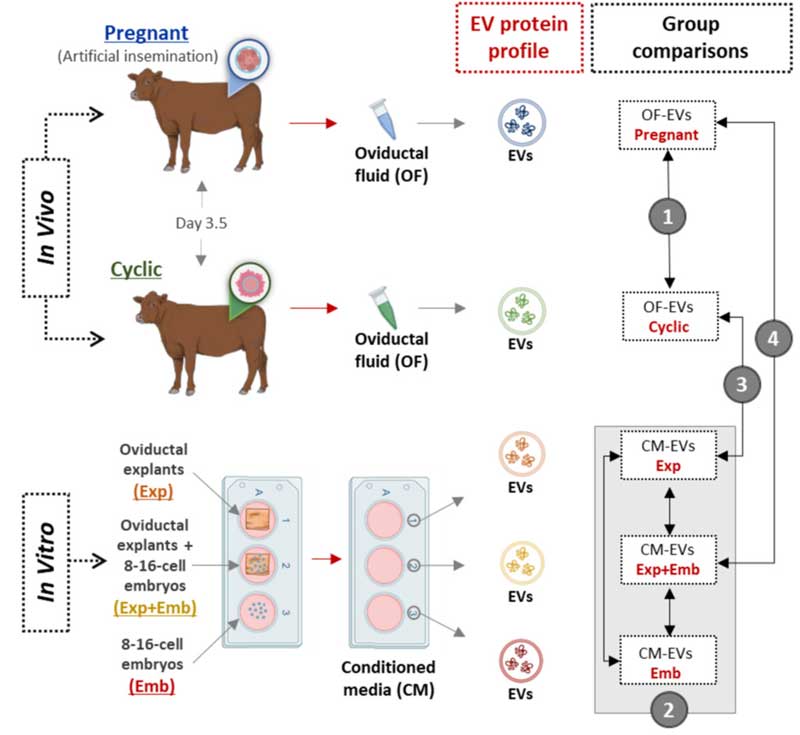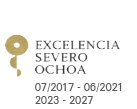
2025/03/31
Extracellular vesicles, key in maternal-embryonic communication, open new possibilities for improving assisted reproduction
An international study, published in Molecular & Cellular Proteomics, with the participation and guidance of researchers from CIC bioGUNE, has revealed the role of extracellular vesicles (EVs) in maternal-embryonic communication.
The research identified differences in the proteins of EVs from oviductal fluid, crucial for embryonic development and maternal-embryo interaction.
These findings could open new pathways to improve embryonic viability and increase success rates in assisted reproduction treatments.
A recently published international study in Molecular & Cellular Proteomics, led by INIA-CSIC in Madrid and with the participation of researchers from CIC bioGUNE, member of BRTA, has provided new data on the role of extracellular vesicles (EVs) in maternal-embryonic communication. The research involved collaboration with the Exosomes Laboratory led by Ikerbasque Research Professor Juan Manuel Falcón, and the Proteomics Platform at CIC bioGUNE, directed by Dr. Félix Elortza, both researchers from CIBER network.
The study focused on a detailed analysis of the protein profiles present in EVs from oviductal fluid of pregnant and cyclic heifers, identifying significant differences in the composition of these vesicles. This suggests that certain proteins play a crucial role in embryonic development and maternal communication. Proteins associated with essential reproductive functions such as energy metabolism, embryonic adhesion, and immune tolerance were identified.
A key aspect of the research was the comparison between in vivo and in vitro models to determine how the presence of embryos affects the protein content of EVs in oviductal fluid. The results indicated that changes in the protein composition of these vesicles facilitate interaction between the embryo and maternal tissues, a key process for successful gestation. The proteins identified in pregnant heifers seem to prepare the reproductive environment for embryo implantation, which could have relevant implications for improving assisted reproduction techniques.
The work addressed three main objectives related to maternal-embryonic communication. The first was to examine the protein content of EVs from the oviductal fluid of cyclic and pregnant heifers to understand their role in maternal-embryonic communication under natural conditions. The second objective was the characterization of protein profiles in cell cultures, investigating EVs present in conditioned media from oviduct explants cultured alone or in the presence of embryos at early stages. Lastly, a comparison between in vivo and in vitro models was conducted, analyzing differences in the protein load of EVs in both contexts and revealing variations in maternal-embryonic communication depending on the experimental environment.
The research identified a set of differentially abundant proteins (DAPs) with essential functions in embryonic development. Among them, those related to energy metabolism, such as MDH1, IDH1, and TPI1, which regulate metabolic pathways supporting embryo development, were highlighted. Proteins involved in DNA repair, crucial in the early stages of development, were also identified. Additionally, proteins that promote embryo acceptance by the maternal immune system, as well as those involved in structural activity and intercellular communication, essential for cellular integrity, were found.
These findings reinforce the hypothesis that supplementation with EVs from the oviductal fluid of pregnant animals could improve embryonic development in in vitro procedures by containing critical components that may optimize implantation and gestational success. Furthermore, they offer a new perspective on the mechanisms of maternal-embryonic communication and open the door to possible applications in the field of fertility and assisted reproduction, potentially leading to innovative strategies to improve embryonic viability and increase success rates in assisted fertilization treatments.
Reference: Rosane Mazzarella, José María Sánchez, Beatriz Fernandez-Fuertes, Sandra Guisado Egido, Michael McDonald, Alberto Álvarez-Barrientos, Esperanza González, Juan Manuel Falcón-Pérez, Mikel Azkargorta, Félix Elortza, Maria Encina González, Pat Lonergan, Dimitrios Rizos. Embryo-Induced Changes in the Protein Profile of Bovine Oviductal Extracellular Vesicles. Molecular & Cellular Proteomics. DOI: 10.1016/j.mcpro.2025.100935.
About CIC bioGUNE
The Centre for Cooperative Research in Biosciences (CIC bioGUNE), member of the Basque Research & Technology Alliance (BRTA), located in the Bizkaia Technology Park, is a biomedical research organization conducting cutting-edge research at the interface between structural, chemical, molecular and cell biology, with a particular focus on generating knowledge on the molecular bases of disease, for use in the development of new diagnostic methods and advanced therapies.
About Ikerbasque
Ikerbasque - Basque Foundation for Science - is the result of an initiative of the Department of Education of the Basque Government that aims to reinforce the commitment to scientific research by attracting, recovering and consolidating excellent researchers from all over the world. Currently, it is a consolidated organization that has over 350 researchers/s, who develop their work in all fields of knowledge.
About BRTA
BRTA is an alliance of 4 collaborative research centres (CIC bioGUNE, CIC nanoGUNE, CIC biomaGUNE y CIC energiGUNE) and 13 technology centres (Azterlan, Azti, Ceit, Cidetec, Gaiker, Ideko, Ikerlan, Leartiker, Lortek, Neiker, Tecnalia, Tekniker y Vicomtech) with the main objective of developing advanced technological solutions for the Basque corporate fabric.
With the support of the Basque Government, the SPRI Group and the Provincial Councils of the three territories, the alliance seeks to promote collaboration between the research centres, strengthen the conditions to generate and transfer knowledge to companies, contributing to their competitiveness and outspreading the Basque scientific-technological capacity abroad.
BRTA has a workforce of over 4,000 professionals, executes 22% of the Basque Country's R&D investment, registers an annual turnover of more than 300 million euros and generates 100 European and international patents per year.
See a large version of the first picture





